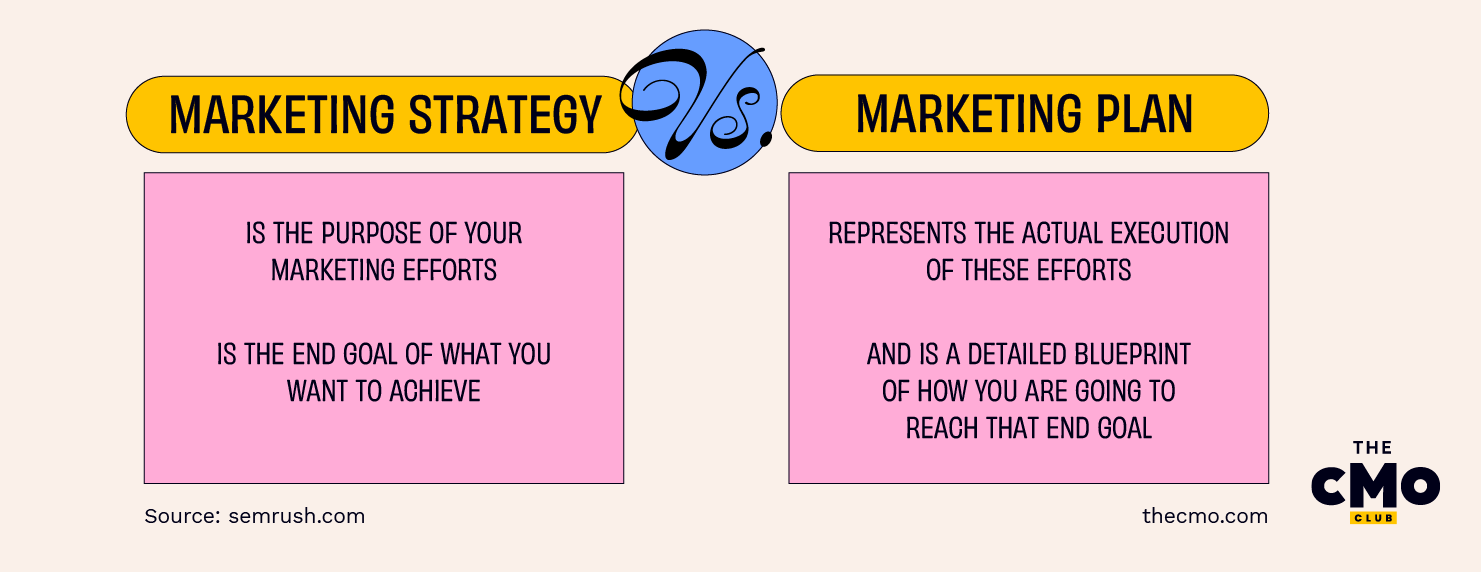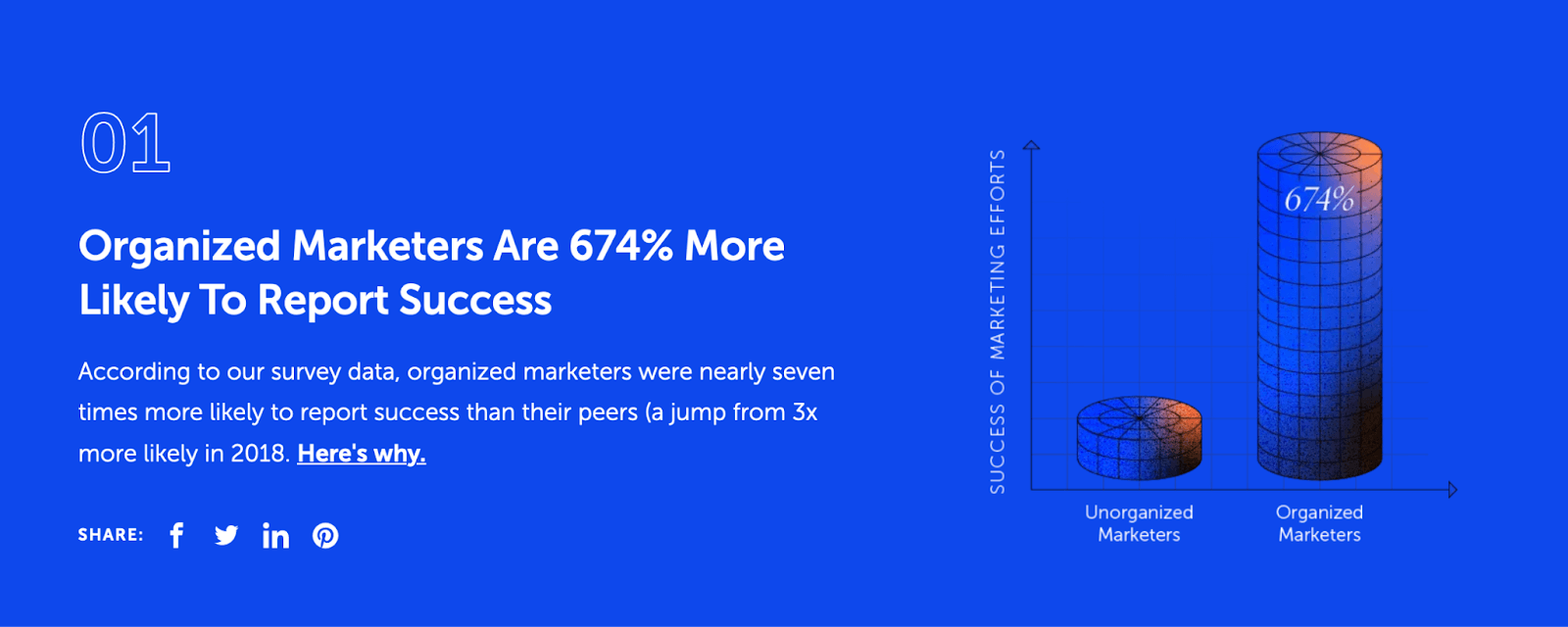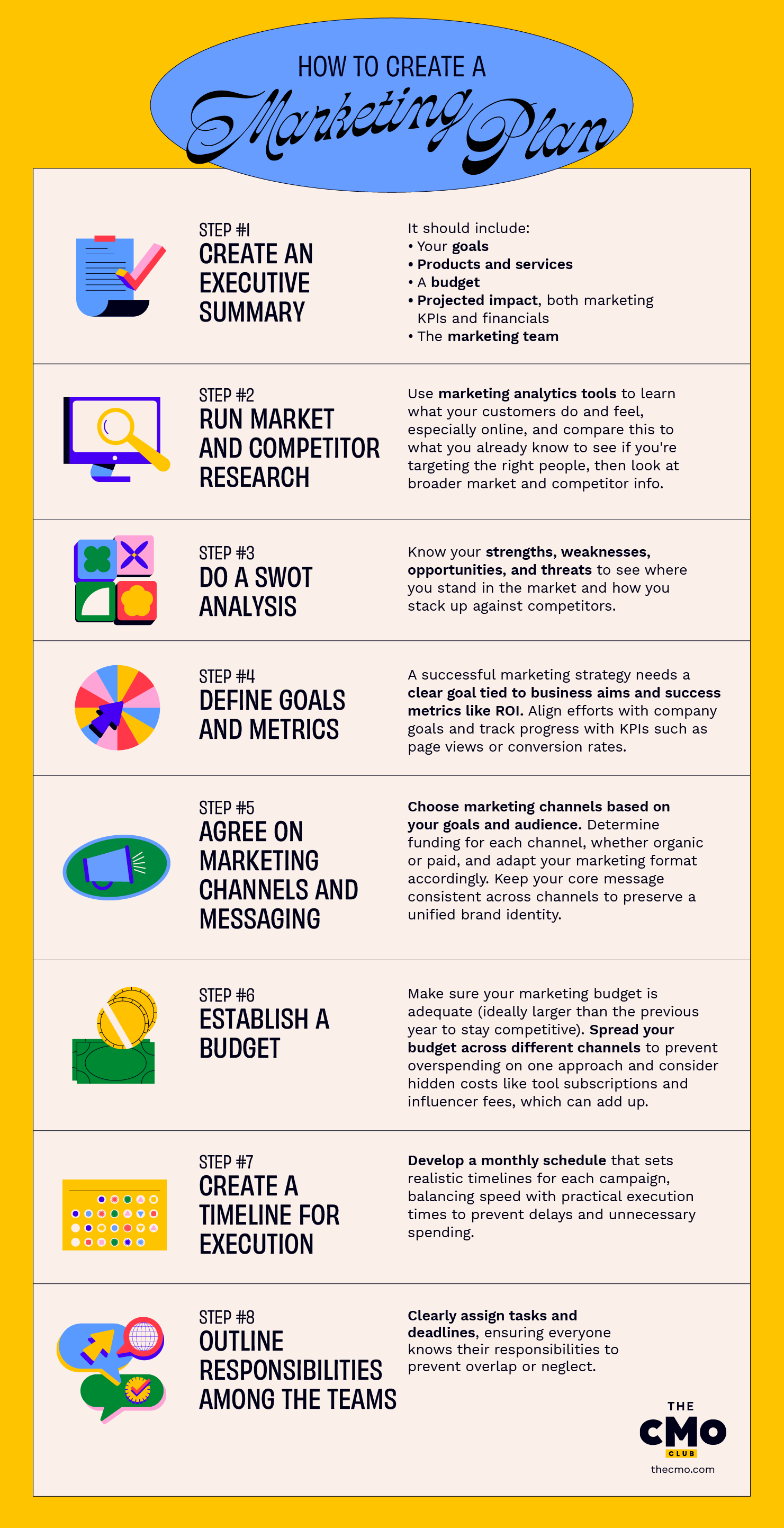Keeping your team on the same page was hard enough when you were a marketing manager in charge of a couple of employees.
It’s a whole other game as a CMO. You're responsible for making sure entire departments are pulling together in the same direction. So, creating a marketing plan that aligns the various marketing teams and then ladders up to the overall goals of the business is key to getting it right.
Let's walk through how to build a marketing plan that hits all the right notes.
I’ll even throw in some example plans and templates you can use to get started. But first, let's take a stab at the differences between creating a marketing strategy and drafting out a marketing plan.
What’s the Difference Between a Marketing Strategy and a Marketing Plan?
A common mistake I see is marketing managers create a marketing strategy, when they should be creating a marketing plan. These two terms sound similar, but it’s important to remember they are two different things.
Worse, “marketing strategy” is such a nebulous term that it can be defined in several different ways.
One common definition is that it’s a holistic view of your company's goals and the way you aim to accomplish them. It can include information on the types of channels and campaigns you will run, but it doesn’t go into a huge amount of detail. That’s where a marketing plan comes in.
A marketing plan is the way in which you are going to reach your goal. It’s a detailed guide of what you are going to do, when you are going to do it, and how much it costs. While marketing strategies are blue-sky thinking, marketing plans are grounded in reality.

Another definition of marketing strategy is the actual marketing activities you’ll use to achieve your goal—things like PPC marketing or an influencer campaign.
For example, a SaaS software company might create a marketing plan with the goal of attracting more top-of-funnel leads. The plan would include how the company could leverage several marketing tactics, such as SEO, content marketing, and PPC advertising to achieve those goals.
In either case, make sure you're creating a detailed marketing plan and not a marketing strategy—however you define it.
Why You Need a Marketing Plan
I imagine you’ve been told you need to create a marketing plan dozens of times in your career. But I bet few managers have ever stopped to explain why. Let’s do this now.
Align Your Entire Marketing Team
I’m sure you’re well aware of how unwieldy large marketing teams can be, even if every department has an experienced leader. Everyone wants to explore the latest strategy trend, and it often results in people pulling in the opposite direction to the detriment of growth.
A marketing plan aligns your team around a common goal, ensuring everyone is pulling in the same direction.
It also clarifies how interdependent each department is on one another. Few marketing plans can use one channel and be successful. Multi-channel approaches that share similar messaging, however, can be very powerful.
Organize Your Teams Around the Plan
There’s a reason why journaling has become such a popular wellness habit over the last decade. The simple act of writing things down on paper is a great way to straighten out your thoughts and get clear on what matters most.
A marketing plan is no different. Creating a plan forces you to define what you want to achieve and how you’re going to achieve it. It naturally makes you become more organized, both because you know what you want to do and also because you’re suddenly responsible for making it happen.

Odds are, you’ll become a more effective marketer as a result. Studies show that organized marketers are 674% more likely to report success.
Connect Marketing Efforts to Wider Corporate Goals
Once you reach the upper echelons of marketing management, it becomes vital to connect your marketing efforts to wider corporate goals. Your job hinges on your ability to prove to stakeholders that your department is moving the business forward.
And there’s no better proof than a carefully thought-through marketing plan. Not only will creating it help you to clarify exactly how each department can contribute to wider company goals, but it’s also a fantastic piece of collateral to send to executives.
Improve ROI
This one seems pretty obvious, right? But it’s still important to point out the value that a detailed marketing plan adds to your bottom line. Even if you eat up a week or more creating it, it is still absolutely worthwhile.
The process of creating a marketing plan helps you clarify not just the strategies you need to reach your goals, but the costs of implementing those strategies. What’s more, you can combine the plan with historical marketing performance data to estimate potential ROI and see just how far your initial budget will take you.
How to Create a Marketing Plan
You've been in marketing for years, and you’re finally in a leadership position. Now it’s time to make your first marketing plan. I bet you know what you need to do, and I’ve collated some helpful tips on how to do it right.

Step #1. Create an Executive Summary
You probably know from experience that you’re not the only person who’s going to read your marketing plan. And you also know that there’s nothing worse than having one put on your lap that doesn’t contain a succinct summary at the start. Unsurprisingly, then, this is the first thing that should go into your marketing plan.
If you’re not familiar with what an executive summary is, think of it as the topline of your marketing plan—your elevator pitch. It should include:
- A mission statement (a summary of the goals you are trying to achieve)
- An overview of the products and services you are trying to promote
- A budget
- Projected impact, both marketing KPIs and financials
- Marketing team members and their responsibilities
Here’s my tip: the executive summary may be the first thing in your marketing plan, but it is actually the last thing you should write. While you may have an idea of the goals you want to achieve before you write your plan, I promise you’ll find it a whole lot easier to summarize all of your points at the very end. Heck, you could even get ChatGPT to do it for you.
Step #2. Run Market and Competitor Research
I bet you know heaps about your competitors and the wider market. But that doesn’t excuse you from completing in-depth market research when creating your marketing plan.
The good news is that you probably have a lot of information about your target market hidden away in your proprietary data. Use marketing analytics tools to better understand how your customers behave. Then combine social media analytics and social media listening tools to understand customer behavior and sentiment online.
I bet your CRM is also a goldmine of market data. Get as much information as you can about the people buying your products and see how they compare to your existing customer personas. Are they a match? Or do you need to revise your target audience?
Once you’ve exhausted your own data, use one or more marketing intelligence software tools to get a broader view of the target market and understand how your competitors are leveraging channels to achieve their goals.
Step #3. Do a SWOT Analysis
Next, you’ll want to run a SWOT analysis to understand your strengths, weaknesses, opportunities, and threats—visualizing your place in the market and how you compare to your competitors.

It might have been a little while since you last ran a SWOT analysis, so I’ll briefly recap the steps:
- Strengths: What sets you apart in the market? List the features, skills, or capabilities your company has that can’t be easily copied by competitors. Superior patented technology is a significant strength, for example. Low prices (which are easily copied) aren’t.
- Weakness: What’s holding your business back from achieving its goals? These can be things like an outdated logistics process, a poor reputation, or a lack of funding.
- Opportunities: List all of the ways your business can grow in the year ahead. What can you do to get ahead of the competition? You could enter new markets, for example, create a new product, or increase sales to existing customers.
- Threats: Name the things that can have a negative impact on your business. These can be intrinsic issues like a talent shortage or external factors like a looming recession, inflation, or a newly funded competitor.
SWOT analyses can seem daunting, and I don’t blame you for wanting to skip this step. But it’s a great way to visualize how your business can move forward and the strengths you should leverage to do so. The good news is that running a SWOT analysis becomes a heck of a lot easier once you’ve completed competitor and market research—so definitely do that first.
Step #4. Define Goals and Metrics
Every effective marketing plan needs a clearly defined goal and one or more ways to measure success.
Your goal could be anything, but I’d advise to closely relate it to business goals. Driving new traffic is great, but if it isn’t moving the needle with regard to corporate goals, then it doesn’t matter all that much.
It’s a lot easier to give advice on how to measure your efforts. One of the most common measurement methods is return on investment, or ROI. At a minimum, I imagine you’ll be expected to generate some level of return on your ad spend. The only exception would be running a brand awareness marketing campaign.
ROI is rarely the only metric, however. In my experience, comprehensive marketing plans are almost always tied to one or more short or long-term marketing objectives. That could be increasing website traffic, growing your social media following, or increasing the number of newsletter subscribers.
Whatever your goals, you’ll need to set key performance indicators (KPIs) you can measure through the campaign to assess your progress. Let’s look at a couple of examples:
If you are trying to grow the top of your funnel by increasing website traffic or newsletter subscribers, you’ll want to track metrics like:
- Page views
- Clickthrough rate
- Bounce rate
- Cost per click
Bottom-of-the-funnel goals like increasing sales of a certain product will require tracking different metrics:
- Product views
- Bounce rate
- Conversion rate
- Cart abandonment rate
- Average order value
I recommend periodically measuring these KPIs during the execution of your marketing plan in order to optimize your efforts in real time.
Given the plethora of tracking and analytics tools available to the modern marketer, I don’t believe there’s an excuse for plodding along with a marketing plan that isn’t generating results. Part of your role as CMO is to realize when things aren’t working out and pivot.
Step #5. Agree on Marketing Channels and Messaging
Now we’re getting to the meat of your marketing plan—choosing your marketing channels and your messaging. It also happens to be one of the most important parts of the process.
Most marketing plans will use a multi-channel approach, but it’s not unusual for specific department-level plans to focus entirely on a single channel (Google Ads, for example). Bear this in mind when following my advice below.
Obviously, it’s important to take your goals and target audience into account when choosing marketing channels. If you want to grow sales and revenue, social media may not provide the best ROI. If you want to grow brand awareness, however, social media is a much better bet.
Next, explain how you plan to fund using each marketing channel, whether that’s organically or some form of paid promotion. And what form your marketing will take. In some cases, your hand will be forced by the ad platform. You can only run a couple versions of PPC ads on Google Ads, for instance. However, on other platforms, like Facebook advertising, you can use multiple formats like image, text, or video.
Finally, outline the messaging you’ll be using across every channel. It’s important to do this last because your messaging shouldn’t change regardless of how many channels you use. The format may change in line with the advertising platform, but a target customer should receive the same message whether they find your brand on Facebook, Google, or on a billboard.
Step #6. Establish a Budget
You need to spend money to make money. But you shouldn’t be signing off on ad spend without a firm idea of how your budget should be spent.
The first step is to make sure you have enough marketing budget—and to fight for more if you don’t. Ideally, your marketing budget should be bigger than the year before. A Gartner survey shows marketing budgets increased to 9.5% of total company revenue in 2022, and three in four CMOs reported an increase in budgets.

That means you risk falling behind competitors if your budget hasn’t got bigger. While you can run almost any marketing plan on a tight budget, stronger competition makes it much more difficult.
Once you’ve ring-fenced enough budget to execute your marketing plan, break down how the budget will be spent across each channel.
You’ll want to bear in mind the advice of Geoff Crain, Senior Director, Sales and Marketing at Kingstar Media, when doing so. One of the most common mistakes he sees is businesses allocating too much budget to a single tactic:
“Advertising can be very unpredictable and impacted by a variety of factors. Creating a fluid budget that allows for optimizations and shifts based on performance is necessary. This can be avoided by not locking in dollars to long term commitments with vendors.”
You’ll want to make sure you’re accounting for hidden costs, too. Expenses like tool subscriptions and the cost of giving products to influencers may be minimal, but they can add up at scale.
Step #7. Create a Timeline for Execution
We’re nearly finished. One of the final things to do is to create a month-by-month schedule of how you’ll execute your plan. Obviously you want things to happen as quickly as possible, but you’ll need to set realistic time frames to avoid delaying campaigns and wasting ad spend.
Marketing planning software can be an incredible resource here, and many have pre-built marketing plan templates to get you started. Check out our roundup of the best marketing planning software.
Step #8. Outline Responsibilities Among the Teams
Your final task is to outline responsibilities. Be very clear about who is doing what and when they’re meant to be doing it. On large teams, it’s easy to think someone else is doing a task when no one actually is.
But be careful of taking things too far. Even if you’re the most detail-oriented CMO in history, I don’t recommend you go as far as detailing the day-to-day or week-to-week tasks of individual team members. That’s one surefire way to upset your colleagues.
Examples of Common Types of Marketing Plans
The great thing about marketing plans is they can be as detailed and specific as you like. You can create a cross-departmental marketing plan that covers your team’s activities for the entire year, or you can create separate marketing plans for each channel you target.
General Marketing Plan
This is the most common type of marketing plan you’re likely to create as a CMO. These annual or quarterly plans detail the overarching strategies your company will pursue over that timeframe.
Of course, the breadth of these plans means they are the longest to create and the most detailed. You’ll almost certainly be using multiple channels and should have a hefty budget to achieve your goals. They can also be the hardest to get started. That’s why I’ve dug up the following templates and examples you can use to get a headstart.
This marketing plan template by Evernote is a great place to start. It includes all of the sections I’ve mentioned in this article and even a few more.
If you’re wondering how to fill it out, then check out this example marketing plan from cosmetics company Lush. If you’re looking for design inspiration, then this 2021 marketing plan from the University of Illinois shows how you can make a marketing plan that’s both informative and easy to read.
Content Marketing Plan
A content marketing plan focuses on the different types of content and content-related strategies you’ll use to achieve business and marketing goals. Because this is a narrower form of a marketing plan, those goals will also be much more targeted and specific. Think “generate 500 email signups within six months” instead of “increase top-line revenue by $100,000 by Q3”.
You’ll also probably use fewer marketing channels—and maybe only one. SEO does go hand in hand with content marketing, though, and there’s no reason you can’t run a paid PPC campaign to a landing page where a potential customer can download your white paper.
Start creating your own content marketing plan today using this template from Backlinko or this slightly more visual version from Venngage.
Social Media Marketing Plan
In a similar vein to the content marketing plan above, a social media marketing plan will detail the social media strategies you will use to achieve marketing goals.
This type of marketing plan is growing in popularity at the moment. Social media is the #1 marketing channel in 2022, according to a HubSpot survey, so I think it’s highly likely you’ll need to know how to create one regardless of whether you’re a B2B or B2C brand.
Unlike content marketing, it is much more likely your social media marketing plan will cover multiple channels and include both organic and paid strategies.
Start your plan by reading our advice on how to refine your social media strategy. Next, use this guide by Buffer to create your plan step-by-step. Finally, you can use this template by Zapier to get your thoughts in order.
Paid Media Marketing Plan
This is another highly focused marketing plan. Much like its content marketing counterpart, a paid media marketing plan will typically have a narrow focus of just a couple of channels and a few very specific goals.
Accurately forecasting and managing budgets is an essential part of a paid media plan. There’s nothing worse than running through your budget within the first month or not having a big enough budget to continue investing in ads when you start to see ROI skyrocket.
So is setting informative KPIs and tracking them regularly. Your team needs to know how well ads are performing and to optimize them accordingly to maximize the ROI of a campaign.
PPC Hero has a great guide on how to create the perfect PPC marketing plan. You can follow their advice and use this template from HubSpot to create your paid marketing plan fast.
Go-to-Market Plan
A go-to-market plan is a specialized form of marketing plan that outlines how your company will bring a new product or service to market. While it covers many of the points I’ve outlined above, there are unique elements to a go-to-market plan that means it deserves its own guide.
If you want a step-by-step guide that takes you through the process, then check out Miro’s pre-built template.
Learn More Marketing Tips
The best tip I have when creating a marketing plan is to not think of it as a chore. It’s not a task you have to complete to please stakeholders. Rather, it’s a chance to showcase your ability to lead your team and direct their energy to achieving company goals. Don’t rush, either—especially if it’s your first time creating a marketing plan as a CMO.
If you want to take a break from market research and budgeting, check out one of our recommended marketing books. And don’t forget to subscribe to our newsletter for even more marketing tips.


